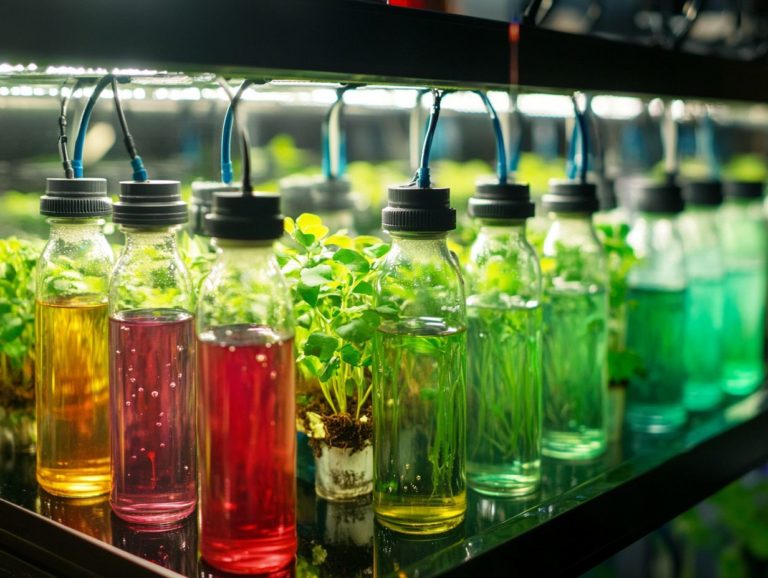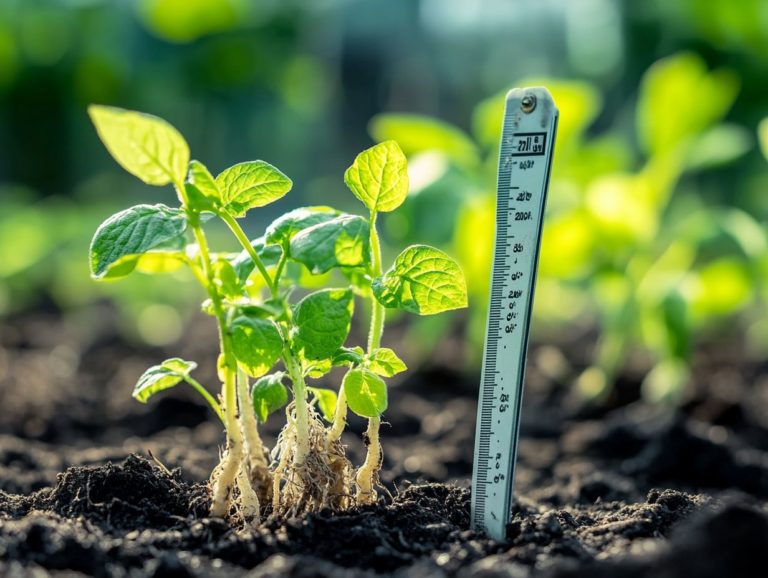Nutrient Requirements for Different Plant Types
Plants, much like you, have specific nutrient needs that are vital for their growth and overall health. This article delves into the essential macronutrients nitrogen, phosphorus, and potassium and their roles in plant development, alongside the crucial micronutrients such as calcium, magnesium, and sulfur.
You ll explore how factors like soil composition and plant species influence these requirements. We will also cover practical tips on selecting the right fertilizers and managing nutrients effectively.
Jump in and learn how to supercharge your plants for amazing growth!
Contents
- Key Takeaways:
- Macronutrient Requirements for Plants
- Micronutrient Requirements for Plants
- Factors Affecting Nutrient Requirements
- Meeting Nutrient Requirements
- Frequently Asked Questions
- What are nutrient requirements for different plant types?
- Why is it important to understand nutrient requirements for different plant types?
- What are some common nutrients required by plants?
- Do all plants have the same nutrient requirements?
- How can I determine the nutrient requirements for a specific plant?
- What happens if a plant does not receive enough of a certain nutrient?
Key Takeaways:

- Plants have different nutrient requirements based on their type, growth stage, and soil composition.
- Macronutrients like nitrogen, phosphorus, and potassium, along with micronutrients like calcium, magnesium, and sulfur, are essential for plant growth and development.
- Choosing the right fertilizer and proper nutrient management are crucial for meeting the nutrient requirements of different plant types.
Overview of Essential Nutrients
Essential nutrients are vital for your plants’ growth and development. They include macronutrients like nitrogen, phosphorus, and potassium, as well as micronutrients such as iron, manganese, zinc, and copper. These nutrients are crucial for processes like chlorophyll production, root development, and overall nutrient absorption. All of these ensure robust crop production and high yields.
To keep your plants thriving, knowing the balance of these nutrients in your soil is key! This balance minimizes deficiencies and fosters sustainable agricultural practices.
By incorporating adequate levels of both macronutrients and micronutrients, you can significantly enhance a plant’s ability to photosynthesize effectively, which is the process plants use to turn sunlight into food. This improves the plant’s resilience against environmental stresses. For example, nitrogen is essential for producing amino acids, which are the building blocks of proteins vital for growth. Micronutrients like zinc also play a pivotal role in enzyme function, impacting various metabolic processes.
Educating yourself and other agricultural professionals about the symbiotic relationship between these nutrients promotes optimized crop performance and supports eco-friendly farming techniques, ultimately leading to healthier ecosystems.
Macronutrient Requirements for Plants
Your understanding of macronutrient requirements for plants hinges on the availability of key elements like nitrogen, phosphorus, and potassium collectively known as N-P-K. These essential nutrients play a vital role in numerous plant functions, from energy storage to the intricate dance of photosynthesis.
Ensuring that these elements are present in the right amounts is crucial for fostering healthy plant growth and optimal function.
Role of Nitrogen, Phosphorus, and Potassium
Nitrogen, phosphorus, and potassium the primary macronutrients are essential players in the growth of your plants. Nitrogen is critical for protein synthesis and chlorophyll production, while phosphorus facilitates energy transfer and supports robust root development. Potassium, on the other hand, regulates numerous physiological functions, including water balance.
These vital nutrients not only drive vigorous plant growth but also significantly impact the nutrient absorption processes that are fundamental to successful agriculture. A lack of nitrogen can cause stunted growth and yellowing leaves because adequate protein synthesis is hampered. Insufficient phosphorus leads to poor root systems and delayed maturity.
A lack of potassium can throw off water regulation, leaving your plants vulnerable to disease and less resilient against environmental stressors. In essence, imbalances or deficiencies in these critical macronutrients can severely affect both yield and quality. This underscores the necessity of effective soil management and nutrient applications in achieving successful farming outcomes.
Micronutrient Requirements for Plants
Micronutrient requirements for your plants, including essential elements like calcium, magnesium, and sulfur, might not be needed in large quantities, but they are vital for ensuring optimal health and development.
These micronutrients significantly influence critical processes such as enzyme function and photosynthesis, playing a key role in your plants overall vitality.
Importance of Calcium, Magnesium, and Sulfur

Calcium, magnesium, and sulfur are essential micronutrients fundamental to your plants’ health and growth. They strengthen cell structures and promote photosynthesis. These processes contribute to maintaining healthy soil and optimal plant development.
Calcium plays a pivotal role in bolstering the structural integrity of cell walls. This enhances your plants’ overall stability and resistance to diseases.
Magnesium is a crucial component of chlorophyll. It ensures that your plants efficiently capture sunlight for photosynthesis.
Sulfur is critical for synthesizing essential amino acids and proteins, both of which are vital for plant growth and development.
To effectively supply these nutrients, consider incorporating organic amendments like compost or green manure. These additions enrich the soil and enhance microbial activity. This natural nutrient use is vital for sustainable agricultural practices, reducing reliance on synthetic fertilizers and fostering environmentally friendly farming methods.
Other Essential Micronutrients
In addition to calcium, magnesium, and sulfur, essential micronutrients like iron, manganese, zinc, copper, boron, molybdenum, and chlorine support various physiological functions in plants. These include enzyme production and nutrient transport.
Each of these micronutrients plays a specific role in the grand tapestry of plant health. For example, iron is critical for chlorophyll synthesis and photosynthesis. Manganese aids enzyme activation and bolsters disease resistance. Zinc is involved in protein synthesis and growth regulation, while copper is crucial for photosynthesis and lignin formation.
A deficiency in any of these essential elements can lead to issues such as stunted growth, chlorosis, or poor fruit development. By conducting thorough soil testing, you can pinpoint these deficiencies early, enabling precise nutrient management that fosters optimal health and productivity in your crops.
Factors Affecting Nutrient Requirements
Several factors influence your plants’ nutrient requirements. These include soil composition and pH levels that affect nutrient availability. Each plant species has its specific needs, which can vary depending on their growth stage.
Understanding nutrient needs can feel complex, but it s essential for thriving plants!
Soil Composition and pH Levels
Soil composition and pH levels are crucial in determining nutrient availability. Maintaining the right pH ensures that essential nutrients remain soluble and accessible for your plants. Conducting soil tests is vital for identifying any imbalances that could hinder growth.
It s important to understand how different soil types whether sandy, clayey, or loamy affect nutrient retention and leaching. For example, sandy soils drain quickly, which can lead to nutrient loss. In contrast, clay soils might hold onto those nutrients but struggle with drainage.
By implementing techniques like soil sampling and lab analysis, you can gain valuable insights into nutrient levels and pH. Interpreting these results enables you to make informed decisions about nutrient management practices. This ensures that your plants receive the essential elements they need for optimal growth while also minimizing environmental impact.
Have you tested your soil lately? It s the first step to healthy plants!
Plant Species and Growth Stage
Different plant species have unique nutrient needs that vary with their growth stages. You should adopt tailored nutrient management practices to optimize your crop production.
Understanding these specific requirements is vital for maximizing your crop yields and promoting sustainable agriculture. Leafy greens like lettuce flourish with higher nitrogen levels during their early development. This encourages lush growth.
Fruit-bearing plants, such as tomatoes, pivot toward increased potassium intake as they mature to enhance the quality and size of their fruit. Soil composition, climate, and water availability greatly influence nutrient uptake. Monitor your crops closely throughout each growth phase.
By taking this dynamic approach, you not only support robust plant health but also align with eco-friendly agricultural practices, minimizing waste and ensuring that resources are used efficiently.
Meeting Nutrient Requirements

Meeting the nutrient requirements for your plants is vital for successful agricultural practices. This involves a careful choice of fertilizers, ensuring they are perfectly balanced to promote optimal nutrient absorption while preventing any deficiencies.
Choosing the Right Fertilizer
Choosing the right fertilizers is a crucial step in nutrient management, ensuring that you meet the specific needs of your plants while also promoting soil health and facilitating effective nutrient absorption.
Understanding the various types of fertilizers is essential; you can categorize them into organic and inorganic options, each offering distinct advantages. Organic fertilizers, sourced from natural materials, enhance soil structure and foster biodiversity.
Inorganic fertilizers provide precise nutrient formulations that accelerate crop growth. To make informed decisions, conducting soil tests to identify any nutrient deficiencies is vital. This knowledge helps you make better choices.
Balanced fertilizers play a significant role in sustainable agriculture, supplying essential nutrients in ways that promote both environmental health and crop productivity. This approach ultimately supports the development of a more resilient agricultural system.
Tips for Proper Nutrient Management
Proper nutrient management is key to thriving agriculture. It keeps your plants healthy and productive! Engage in regular soil testing, implement organic amendments, and monitor plant health. This ensures your soil remains healthy and nutrient-rich.
Act now to boost your soil s health! By adopting this proactive approach, you enhance soil fertility and promote a thriving ecosystem. Utilizing practices like crop rotation the practice of growing different crops in the same area across seasons allows you to disrupt pest cycles and prevent soil depletion, which can lead to increased yields over time.
Incorporating organic matter, such as compost or cover crops, further enriches your soil with essential nutrients and improves its structure. This enhancement boosts water retention and microbial activity.
Ultimately, holistic nutrient management cultivates healthier crops and supports biodiversity, contributing to a more resilient and sustainable agricultural system.
Frequently Asked Questions
What are nutrient requirements for different plant types?
Nutrient requirements vary by plant type and include the specific nutrients needed for their growth. Knowing these helps you nurture your plants better.
Why is it important to understand nutrient requirements for different plant types?

Understanding nutrient requirements helps ensure that plants receive the necessary nutrients for healthy growth, yield, and resistance to diseases and pests.
What are some common nutrients required by plants?
Plants need essential nutrients to thrive. Common ones include nitrogen, phosphorus, potassium, calcium, magnesium, and sulfur.
They also require tiny amounts of micronutrients like iron, zinc, and copper. Micronutrients are essential for plant health, even if they’re needed in smaller quantities.
Do all plants have the same nutrient requirements?
No, plants have different nutrient needs. These depend on their species, growth stage, and the environment they re in.
How can I determine the nutrient requirements for a specific plant?
To find out what a specific plant needs, check gardening guides or conduct a soil test. You can also ask a horticulturist or an experienced gardener for advice.
What happens if a plant does not receive enough of a certain nutrient?
A nutrient deficiency can harm your plant. It may lead to stunted growth, yellow or brown leaves, and lower yields, making them more vulnerable to diseases and pests.






